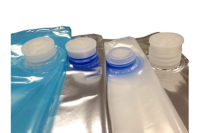Study: Sustainable, recyclable flexible plastics packaging solutions ignite fresh growth opportunities
From a regional perspective, Asia-Pacific is expected to witness the highest growth rate during the forecast period due to the increasing number of dual-income households.

The global flexible plastic packaging market is projected to generate revenues of $172.29 million from 2018-2023 with a steady CAGR of 3.2% during this period, according to a study shared by Frost & Sullivan, San Antonio, Texas. Shifting consumer preferences and an evolving retail landscape have increased the demand for flexible packaging with features such as improved shelf life, convenience and ease of use. Plus, a growing need for innovative flexible plastic packaging options that meet recyclability, regulatory and sustainability standards further augment lucrative market expansion possibilities.
“Due to current regulatory, consumer and environmental pressures, manufacturers are steering their strategies toward circularity and leveraged new plastic technologies to develop recyclable and sustainable solutions that include specific properties such as oxygen, moisture, light, puncture and chemical resistance and easy-tear propagation,” says Prateeksha Kaul, senior research analyst, chemicals, materials and nutrition. “Further key focus areas for manufacturers include the development of alternative bioplastics solutions such as polybutylene succinate and biopolyproplyene. However, competitive factors like price and the disposal of bioplastics will need to be examined to ensure successful usage.”
From a regional perspective, Asia-Pacific is expected to witness the highest growth rate during the forecast period due to the increasing number of dual-income households. While North America faces challenging competition from emerging markets and is set to experience average growth, European regulations regarding recyclability and sustainability of plastics used in packaging are expected to impact this region.
“The persistent growth of the middle-class population in Asia-Pacific is set to be the prime driver for flexible plastic demand owing to the low cost of production,” says Kaul. “Furthermore, an uptick in consumers using e-commerce platforms will drive greater use of flexible plastic packaging associated with shipping products.”
From a competitor position, the supply base is fragmented with multinational companies playing a dominant role in most regions; the Top 5 participants typically cater to less than 30% of the market.
To gain a competitive advantage, Kaul recommends players introduce product innovation aimed at sustainability, enhanced consumer convenience and ensuring higher recyclability.
Additional growth opportunities participants should aim to secure include:
- Expanding operations into emerging regions such as Asia-Pacific, where demand for flexible plastic packaging is expected to surge given the growing need for these products across end-applications.
- Introducing products that promote less use of natural resources, produce less waste, improve shelf life and are cost-effective.
- Increase production capabilities to cater to the growing demand for packaged foods such as ready-to-eat meals, frozen meals and more.
“Despite significant market expansion prospects, durability and the longevity of plastics imply that it takes a lot of effort to degrade, and flexible plastic like bags, films and wrappers end up in landfills or oceans,” adds Kaul. “Furthermore, plastic litter can also impact human health as it moves up the food chain. This, in turn, has exerted pressure on companies and manufacturers to find viable solutions, either by improving the recycling rate or focusing on producing alternatives to plastics.”
Looking for a reprint of this article?
From high-res PDFs to custom plaques, order your copy today!






